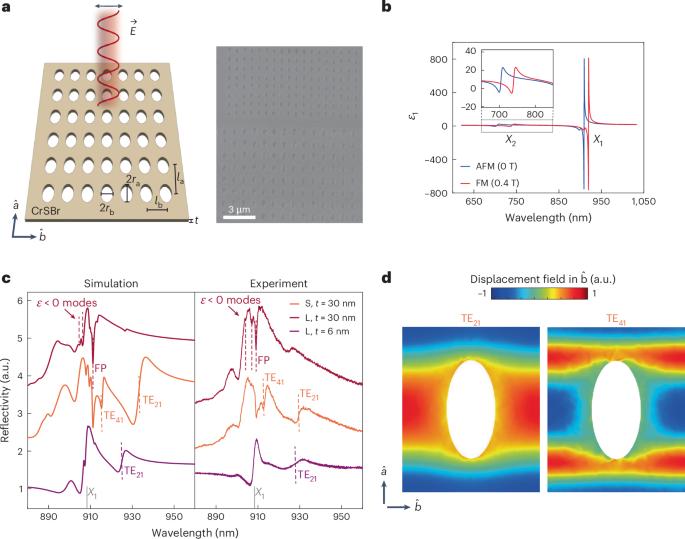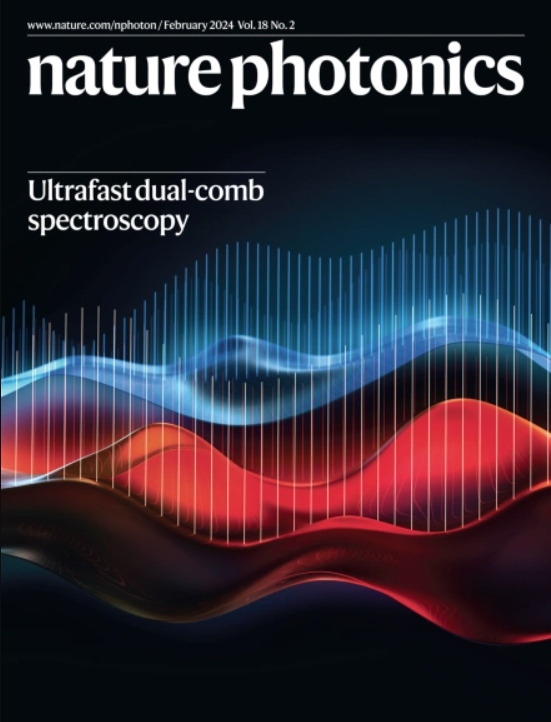基于二维磁体的可调谐纳米光子器件和腔
IF 32.9
1区 物理与天体物理
Q1 OPTICS
引用次数: 0
摘要
纳米光子学领域的核心是设计光通过纳米级结构的能力。这些结构通常具有永久的工作光谱范围和在制造过程中固定的光学特性。量子材料具有相互关联和交织的自由度,为动态控制光子器件而不改变其物理结构提供了一条有前途的途径。在这里,我们用范德华反铁磁半导体CrSBr制作光子晶体板,并演示了对其光学特性的原位控制。利用CrSBr在激子共振附近的超大折射率及其通过外场的可调性,我们实现了近可见光和红外波长光子模式的精确操纵,展示了纳米光子器件设计的新范例。由此产生的光子晶体的引导共振在光谱中紧密堆积,模式体积非常小,可以通过外部磁场高度调谐,并且Q因子超过1200。这些共振自杂化与激子自由度,导致本征强光-物质耦合。我们的发现强调了量子材料在原位可调谐光子元件和腔中的潜力。本文章由计算机程序翻译,如有差异,请以英文原文为准。


Tunable nanophotonic devices and cavities based on a two-dimensional magnet
Central to the field of nanophotonics is the ability to engineer the flow of light through nanoscale structures. These structures often have permanent working spectral ranges and optical properties that are fixed during fabrication. Quantum materials, with their correlated and intertwined degrees of freedom, offer a promising avenue for dynamically controlling photonic devices without altering their physical structure. Here we fabricate photonic crystal slabs from CrSBr, a van der Waals antiferromagnetic semiconductor, and demonstrate in situ control over their optical properties. Leveraging the combination of the exceptionally large refractive index of CrSBr near its excitonic resonances and its tunability via external fields, we achieve precise manipulation of photonic modes at near-visible and infrared wavelengths, showcasing a new paradigm for nanophotonic device design. The resulting guided resonances of the photonic crystal are tightly packed in the spectrum with very small mode volumes, are highly tunable via external magnetic fields and exhibit high Q factors exceeding 1,200. These resonances self-hybridize with the excitonic degrees of freedom, resulting in intrinsic strong light–matter coupling. Our findings underscore the potential of quantum materials for developing in situ tunable photonic elements and cavities. CrSBr, a van der Waals antiferromagnetic semiconductor, is used to fabricate photonic crystal slabs, featuring exceptional in situ control over optical behaviour and thus enabling precise manipulation of photonic modes at near-visible and infrared wavelengths.
求助全文
通过发布文献求助,成功后即可免费获取论文全文。
去求助
来源期刊

Nature Photonics
物理-光学
CiteScore
54.20
自引率
1.70%
发文量
158
审稿时长
12 months
期刊介绍:
Nature Photonics is a monthly journal dedicated to the scientific study and application of light, known as Photonics. It publishes top-quality, peer-reviewed research across all areas of light generation, manipulation, and detection.
The journal encompasses research into the fundamental properties of light and its interactions with matter, as well as the latest developments in optoelectronic devices and emerging photonics applications. Topics covered include lasers, LEDs, imaging, detectors, optoelectronic devices, quantum optics, biophotonics, optical data storage, spectroscopy, fiber optics, solar energy, displays, terahertz technology, nonlinear optics, plasmonics, nanophotonics, and X-rays.
In addition to research papers and review articles summarizing scientific findings in optoelectronics, Nature Photonics also features News and Views pieces and research highlights. It uniquely includes articles on the business aspects of the industry, such as technology commercialization and market analysis, offering a comprehensive perspective on the field.
 求助内容:
求助内容: 应助结果提醒方式:
应助结果提醒方式:


